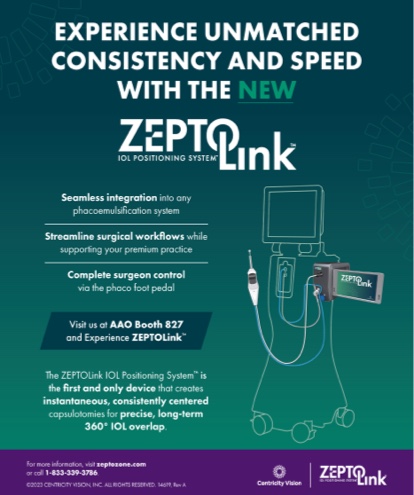In a cataract practice, ultrasound biomicroscopy (UBM) is useful for patients who are experiencing complications after IOL implantation when the media are hazy. In some situations, specialists may not be able to see through the cornea well enough with other imaging devices. UBM allows one to view the anterior segment structure to determine if an IOL implant is in the sulcus or in the capsular bag, to see where it sits in relation to the iris, and to view the angle with respect to the cornea and the vitreous space. UBM is also helpful for determining phakic IOL sizing when the eye has an implant and the surgeon needs to see behind pigmented structures to determine the dimensions of the sulcus.
UBM’s USE IN CLINICAL PRACTICE
When UBM is performed at my colleagues’ and my practice, our technician semireclines the patient in the chair and sets up the imaging device. The technician will typically use the clear scan (ESI), a bag that goes over the tip of the ultrasound probe, so that a water bath is not necessary. A drop of anesthetic is applied to the eye so that the various structures can be visualized. In our practice, we employ a standard scan, during which the patient is imaged from left to right initially. The process is completed with a superior-to-inferior scan that has the probe oriented in the opposite direction. For phakic IOL sizing, the technician obtains a static image in the vertical and horizontal directions as close to the midline as possible. Finally, the technician prints out the chart or stores the video image.
The important midperipheral anterior chamber depth is measured at a 6-mm-diameter zone, the distance from the iris to the endothelium, and then centrally. In some situations, if he or she does not understand complicated anatomy, the technician may ask that the physician complete the imaging.
CASE EXAMPLE
An 82-year-old woman was referred for decreased visual acuity after prior DSEK (Figures 1 and 2). Her visual acuity was hand motion. There was severe corneal edema with no view of the anterior chamber, iris, or the IOL’s details. A high-resolution UBM study was undertaken to establish the relationship of the tissue of the prior DSEK to the IOL, vitreous, and iris. This revealed that the peripheral iris, IOL haptic, and peripheral zonules-cortex-vitreous complex were pushed up against the posterior cornea in the area of the previous scleral incision. Thus, in planning the repair, the surgeon anticipated that the patient would require IOL removal and iris repair.
CONCLUSION
Glaucoma and corneal specialists commonly use UBM, but the technology is extremely useful in many settings, especially in cataract practices. The ability to visualize the anterior segment anatomy through opaque media is valuable and can aid surgical planning. It can eliminate the need for “exploratory” surgery and assist in remedying complications from cataract/IOL procedures.
David R. Hardten, MD, is the director of refractive surgery at Minnesota Eye Consultants in Minneapolis. Dr. Hardten may be reached at (612) 813-3632; drhardten@mneye.com


